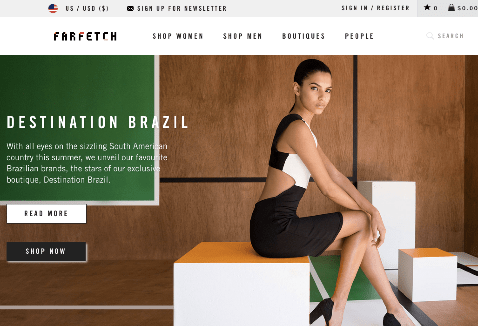Some big news today in the world of fashion e-commerce. Farfetch, the London-based online marketplace for high end fashion retailers, is announcing a raise of $86 million. The funding vaults Farfetch into the unicorn club with a valuation of $1 billion, and it is notable for another reason: it is led by DST Global — the VC firm founded by Yuri Milner that has invested in the likes of Facebook, Twitter, Xiaomi, Alibaba, Flipkart and many more.
Other investors in this round include existing investors Conde Nast and Vitruvian Partners. The funding brings the total raised by Farfetch to nearly $200 million.
Jose Neves, the founder and CEO of Farfetch, tells me that the funding will be used to continue to expand the company’s operations globally.
Farfetch, which was originally founded in 2007, last year expanded to China, Russia and Japan from its core markets of Europe and the U.S., tapping into a growing population of well-heeled consumers who have money buy fashionable clothes but fewer places locally to spend it. The plan is to continue building up those markets as well as tap into further regions like Latin America that fit the same mold, in addition to other, more mature markets like Germany, South Korea and Spain.
The company’s gross merchandise value currently is at around $1 million per day, with the average basket for each customer at between $600 and $700 (a total value that typically covers several items). It’s not clear if the company is profitable right now but it is investing in growth right now. That growth has been very strong up to now. In 2010, when Farfetch picked up its first funding from Advent Venture Partners and Frederic Court, its GMV was only $25,000 per day.
“Farfetch has a strong team, impressive growth and great potential to capitalize on the fast growing luxury fashion e-commerce market,” Yuri Milner, founder of DST Global, noted in a statement. DST has put a lot of its investments to date in juggernauts in U.S. and Asia and it’s rare, but not unprecedented, for the company to invest in Europe. Klarna is also in its portfolio. The payments company Klarna is also in its portfolio.
Farfetch’s business follows a classic marketplace model, similar to others like Snapdeal in India. No inventory is held by Farfetch itself: rather, its power lies in how it connects retailers who sell clothes with consumers who want to buy them.
“We have no plans to launch a private label or add any inventory,” Neves tells me. “The plan is to continue to be a marketplace and connect global retailers.” And while Farfetch started out by focusing specifically on smaller businesses that could not build the same experience on a smaller scale, today that funnel has grown considerably. “We have businesses with 20 stores and large department stores like Galleries Lafayette [in France]. We have very large companies on the platform as well as quirky boutiques. The plan is to roll that out more,” Neves says.
This is also one of the reasons why Farfetch’s investors believe it will not go the way of other e-commerce startups that have tried to play on the marketplace model and fallen. “I think Farfetch is very different from a Gilt or Fab.com,” Court tells TechCrunch. “The main reason those lost their way was the lack of curation and trying to shift too much stuff.”
And there is logic behind why large department stores have followed in the footsteps of smaller ones in coming to Farfetch, Neves says.
“I would say that building an e-commerce site is easier than it has ever been with companies like Shopify, but building a successful commercial operation is harder than it has ever been,” he notes. Part of the reason is because large search engines like Google favor sites with the most interesting content, and Farfetch ticks a box with an approach that mixes curation with a very revolving stock. On top of that there is the issue of logistics. “We get rates and service levels that no one else gets,” he says. “This is impossible to crack even for medium sized companies. So many U.S. retailers still do not ship to South America.”
Today, the company says it brings together some 300 businesses with 450,000 users, numbers that Farfetch hopes to take up a couple of dress sizes with the new capital injection.
As for what the next step will be for the wider business, the funding will, for now, help the company to remain private for the moment. From what we understand, the idea will be for Farfetch to consider a potential IPO at some point down in the next couple of years too, if it doesn’t get snapped up by another e-commerce giant first.
